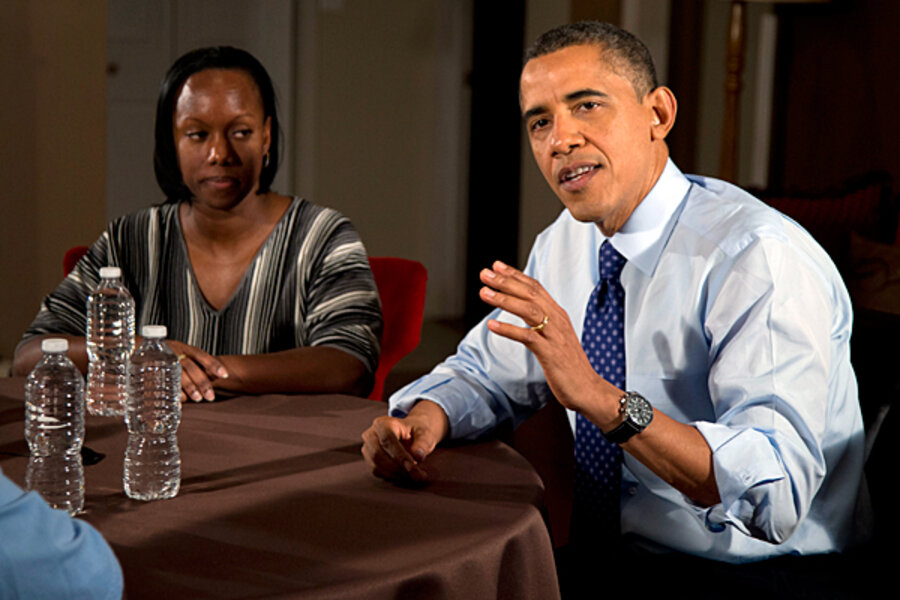'Fiscal cliff': Has Obama overdone the PR?
Loading...
| Washington
Meet Tiffany Santana and her family: She’s a high school English teacher; her husband, Richard, is a porter at a local Toyota dealership; her mom is a child-care provider; and her dad is a postal worker.
This extended family – including the Santanas’ 6-year-old son, Noah – shares an apartment in northern Virginia. On Thursday, when President Obama came to visit, they became the face of middle-class America as he seeks to maintain the Bush-era tax cuts for all but the wealthy while negotiating to avoid the “fiscal cliff.”
“They're keeping it together, they're working hard, they're meeting their responsibilities,” Mr. Obama said at their Fairfax, Va., home. “You know, for them to be burdened unnecessarily because Democrats and Republicans aren't coming together to solve this problem gives you a sense of the costs in very personal terms."
If the Bush tax cuts expire on Dec. 31, the average middle-class family of four would pay an additional $2,200 in income taxes. To Ms. Santana and her family, that’s a month’s rent, she explains in a video put out by the White House.
Another day, another bully-pulpit moment choreographed by a White House determined to see tax rates go up for the top 2 percent of taxpayers. And that sound of gnashing teeth you hear is Republicans expressing frustration that they are getting beat again and again in the public-relations game around the looming fiscal cliff – $607 billion in spending cuts and tax hikes that go into effect at the end of the year if Congress doesn’t act.
"The president has to show up and negotiate,” Rep. Charles Boustany (R) of Louisiana told CNN on Wednesday. “He needs to quit running around the country, sit down across the table from the speaker, get the Senate majority leader in the room, and they need to start working.”
It’s been a month since Election Day, but in a way Obama hasn’t stopped campaigning. He held an East Room press conference on Nov. 14. He made a campaign-style trip to a toy factory in Pennsylvania on Nov. 30 to demonstrate the risk of fiscal-cliff uncertainty during the holiday shopping season. His White House set up a Twitter hashtag – #My2k – aimed at gathering stories from Americans about what $2,000 (i.e., 2k) means to them. So far, 375,000 people have responded, including Santana.
Obama has also held meetings at the White House with CEOs, small-business owners, average Americans, and a bipartisan delegation of governors. His outreach to the private sector also included a speech Wednesday to the Business Roundtable.
Is all this PR coming at the expense of actual negotiating, as Republicans suggest? The White House insists not. Treasury Secretary Timothy Geithner has led negotiations with the Republicans. And Obama has kept in touch with House Speaker John Boehner on the phone. The two spoke on Wednesday.
The flip side of that question is whether the White House has, in fact, been effectively leveraging public opinion as Dec. 31 approaches. In the past few weeks, polls have consistently shown a majority of Americans support higher taxes on incomes over $250,000 – Obama’s bright line in the negotiations – to avoid the fiscal cliff.
It’s impossible to prove that Obama’s PR blitz has affected public opinion, but if you’re the White House, that’s the safer bet. And so analysts expect the president to keep making his pitch to the public until it really is time to cut a deal.
“He feels, and I understand why, that the election was a mandate for raising taxes on the wealthiest, and he doesn’t know how long he’ll have it,” says Larry Sabato, a political scientist at the University of Virginia in Charlottesville.
Just as important as the polls showing support for a tax hike on the wealthy are Obama’s relatively strong job-approval ratings – generally over 50 percent since Election Day.
Obama’s approach “is fine as long as it doesn’t lead to stubbornness and arrogance that takes us over the cliff,” says Mr. Sabato.








